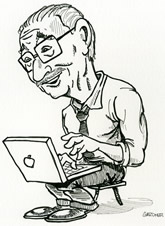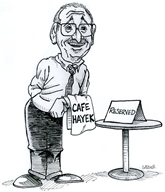Earlier this week, the Wall Street Journal‘s Matthew Hennessey penned a brilliant – and fair – criticism of JD Vance’s uninformed ‘understanding’ of free markets. Mr. Hennessey’s lucid argument obviously struck a nerve in the administration. None other than the vice-president of the United States himself responded. In today’s WSJ, the eminent Thomas Sowell expresses his dissent from Mr. Vance’s lame defense:
In his response to Matthew Hennessey’s op-ed on the market, Vice President JD Vance writes: “One needn’t look far in American history for examples of lawmakers wielding the market to the betterment of our people. President Franklin Roosevelt famously directed the U.S. automotive industry to build the Arsenal of Democracy in World War II” (Letters, May 29). Yet FDR’s greatest contribution to military production in World War II was putting an end to his incessant interventions in the economy, which had created prolonged uncertainty that needlessly extended the Great Depression of the 1930s. In his own words, “Dr. New Deal” had been replaced by “Dr. Win the War.”
Thomas Sowell
Talk about friendly fire. Mr. Trump is attacking the group, and especially the man in Leonard Leo, that were vital to his first-term success on judicial nominations. Mr. Leo helped Mr. Trump pull together his list of potential Supreme Court nominees during the 2016 presidential campaign.
The list was crucial in reassuring conservative voters that he could be trusted on judges. His first nominee, Justice Neil Gorsuch, was on the list. As Mr. Trump said when he nominated Justice Gorsuch, “millions of voters said this was the single most important issue to them when they voted for me for President.”
Mr. Trump’s outburst followed the Court of International Trade’s ruling that the President lacks authority under the International Emergency Economic Powers Act to impose tariffs. One of the judges on that panel, Timothy Reif, was nominated by Mr. Trump in 2018.
But don’t blame the Federalist Society. Judge Reif was recommended to the White House by Robert Lighthizer, who was Mr. Trump’s first-term trade representative. Mr. Leo had nothing to do with it.
Mr. Trump is upset that Judge Reif and two other judges identified limits on the executive’s tariff authority without express Congressional authority. Mr. Trump claims the decision must have been motivated by “purely a hatred of ‘TRUMP’? What other reason could it be?”
Well, how about the law and the Constitution? The panel’s 52-page opinion explains that the emergency act doesn’t give the President unlimited authority to impose tariffs as he sees fit. This is what federal judges are supposed to do, but in Mr. Trump’s universe the only good judge is one who always rules in his favor.
…..
An odd irony of Mr. Trump’s second term is that he has forgotten much of what produced the first-term successes that persuaded GOP primary voters he deserved re-election. His assault on his own judicial legacy is Exhibit A.
Damon Root makes transparent what J.D. Vance finds opaque about the proper role of courts in America. A slice:
James Madison, often called the “father of the Constitution,” made the same point in his June 8, 1789, speech to Congress introducing the Bill of Rights. The proper role of the courts, Madison said, was to act as “an impenetrable bulwark against every assumption of power in the legislative or executive.” Not exactly a ringing endorsement of judicial deference, is it?
Robert Pozen and Ernie Tedeschi ask if “America can dodge a tariff bullet.” A slice:
Contrary to assertions by some administration officials, tariffs aren’t paid by exporting companies or countries but by U.S. consumers and businesses. Studies of the 2018 trade war with China have consistently found that the U.S. bore the cost of the tariffs and that businesses passed on their costs to consumers.
The damage caused by the lower “temporary” tariffs would be significant, according to estimates from the nonpartisan Budget Lab at Yale. As a result of the 2025 tariffs in effect at the beginning of this week, U.S. consumers would face prices 1.7% higher on average in the near term. For the average American household, this would be a loss in purchasing power of $2,800 a year in 2024 dollars. If Mr. Trump follows through on his threatened 50% tariff on goods from the EU, U.S. prices would be 2.2% higher, an average household burden of $3,600.
The Budget Lab projected that because of the 2025 tariffs, U.S. real gross domestic product growth would be 0.7 percentage point lower over this calendar year. Similarly, real business investment in the U.S. would be 0.5 point lower by the end of 2025, and 1.7 point lower by the end of 2026. The tariffs would continue to bite over the next decade.
These figures don’t include the effects that 25% tariffs on pharmaceuticals and semiconductors would have if they are imposed. The U.S. imported $203 billion in pharmaceutical products in 2023. A study by Ernst & Young estimates that a 25% tariff on pharmaceuticals would raise drug costs for the industry by $51 billion annually and increase drug prices for consumers by 12.9%. Tariffs would be particularly damaging for generic-drug makers because they rely heavily on foreign sources for active ingredients.
A 25% tariff on semiconductors likewise would do enormous damage. It would increase costs and drive away U.S. manufacturers in the aerospace, robotics, autonomous vehicles and artificial-intelligence industries, which rely heavily on semiconductors. The Information Technology and Innovation Foundation estimates that a 25% tariff on semiconductors would reduce U.S. economic output and cost the average American $122 in the first year and $4,208 cumulatively over 10 years.
Vance Ginn shares important facts about the state of modern American manufacturing. Two slices:
Manufacturing output in America is booming. According to the Federal Reserve’s Industrial Production Index, US factory output stood at 103.9 in April 2025, near its all-time high. The machines are humming.
…..
Rather than fix what broke labor markets — rigid institutions, perverse tax codes, and regulatory sprawl — today’s political class is dusting off the old playbook of industrial policy.
The logic goes something like this: government should “bring back” manufacturing jobs by picking industries to support, offering subsidies, or restricting imports. This thinking underlies the CHIPS Act, the Inflation Reduction Act, and growing bipartisan calls for trade protectionism.
But industrial policy doesn’t work. It reallocates capital based on political incentives, not economic ones. It props up politically favored firms and industries at the expense of dynamic sectors that don’t have lobbyists in D.C.
More fundamentally, it misunderstands what made America rich in the first place: the freedom to specialize, innovate, and trade. We didn’t prosper by controlling the direction of jobs. We prospered by getting government out of the way.
Even if these policies “succeed” in creating more factory jobs — which is far from certain — they will come at great cost: higher prices, distorted markets, and reduced competitiveness. In trying to become more like China, we risk becoming less like America.
My Mercatus Center colleague Revana Sharfuddin writes – here and here – about AI.
Speaking about AI, Bob Graboyes offers this fascinating combination of it, homo economicus, human cognitive ‘biases,’ and kamikaze missions.



